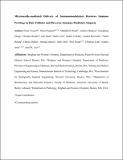| dc.contributor.author | Younis, Nour | |
| dc.contributor.author | Puigmal, Núria | |
| dc.contributor.author | Kurdi, Abdallah El | |
| dc.contributor.author | Badaoui, Andrew | |
| dc.contributor.author | Zhang, Dongliang | |
| dc.contributor.author | Morales, Claudia | |
| dc.contributor.author | Saad, Anis | |
| dc.contributor.author | Cruz, Diane | |
| dc.contributor.author | Rahy, Nadim Al | |
| dc.contributor.author | Daccache, Andrea | |
| dc.contributor.author | Huerta, Triana | |
| dc.contributor.author | Deban, Christa | |
| dc.contributor.author | Halawi, Ahmad | |
| dc.contributor.author | Choi, John | |
| dc.contributor.author | Dosta, Pere | |
| dc.contributor.author | Lian, Christine | |
| dc.contributor.author | Artzi, Natalie | |
| dc.contributor.author | Azzi, Jamil R. | |
| dc.date.accessioned | 2024-05-06T18:56:40Z | |
| dc.date.available | 2024-05-06T18:56:40Z | |
| dc.date.issued | 2024-04-18 | |
| dc.identifier.issn | 0935-9648 | |
| dc.identifier.issn | 1521-4095 | |
| dc.identifier.uri | https://hdl.handle.net/1721.1/154841 | |
| dc.description.abstract | Disorders in the regulatory arm of the adaptive immune system result in autoimmune‐mediated diseases. While systemic immunosuppression is the prevailing approach to manage them, it fails to achieve long‐lasting remission due to concomitant suppression of the regulatory arm and carries the risk of heightened susceptibility to infections and malignancies. Alopecia Areata is a condition characterized by localized hair loss due to autoimmunity. The accessibility of the skin provides an opportunity for local rather than systemic intervention to avoid broad immunosuppression. We hypothesized that expansion of endogenous regulatory T cells (T<jats:sub>regs</jats:sub>) at the site of antigen encounter can restore the immune balance and generate a long‐lasting tolerogenic response. We therefore utilized a hydrogel microneedle (MN) patch for delivery of CCL22, a chemoattractant for T<jats:sub>regs</jats:sub>, and IL‐2, a T<jats:sub>reg</jats:sub> survival factor to amplify them. In an immune‐mediated murine model of alopecia, we showed local bolstering of T<jats:sub>reg</jats:sub> numbers leading to sustained hair regrowth and attenuation of inflammatory pathways. In a humanized skin transplant mouse model, we confirmed expansion of T<jats:sub>regs</jats:sub> within human skin without engendering peripheral immunosuppression. The MN patch offered high‐loading capacity and shelf‐life stability for prospective clinical translation. By harmonizing immune responses locally, we aspire to reshape the landscape of autoimmune skin disease management. | en_US |
| dc.language.iso | en_US | |
| dc.publisher | Wiley | en_US |
| dc.relation.isversionof | 10.1002/adma.202312088 | en_US |
| dc.rights | Creative Commons Attribution-Noncommercial-Share Alike | en_US |
| dc.rights.uri | http://creativecommons.org/licenses/by-nc-sa/ | |
| dc.source | Wiley | en_US |
| dc.title | Microneedle‐mediated Delivery of Immunomodulators Restores Immune Privilege in Hair Follicles and Reverses Immune‐Mediated Alopecia | en_US |
| dc.type | Article | en_US |
| dc.identifier.citation | N. Younis, N. Puigmal, A. E. Kurdi, A. Badaoui, D. Zhang, C. Morales, A. Saad, D. Cruz, N. A. Rahy, A. Daccache, T. Huerta, C. Deban, A. Halawi, J. Choi, P. Dosta, C. Lian, N. Artzi, J. R. Azzi, Microneedle-mediated Delivery of Immunomodulators Restores Immune Privilege in Hair Follicles and Reverses Immune-Mediated Alopecia. Adv. Mater. 2024, 2312088. | en_US |
| dc.contributor.department | Massachusetts Institute of Technology. Institute for Medical Engineering & Science | |
| dc.relation.journal | Advanced Materials | en_US |
| dc.eprint.version | Author's final manuscript | en_US |
| dc.type.uri | http://purl.org/eprint/type/JournalArticle | en_US |
| eprint.status | http://purl.org/eprint/status/PeerReviewed | en_US |
| dspace.date.submission | 2024-05-06T18:34:18Z | |
| mit.license | OPEN_ACCESS_POLICY | |
| mit.metadata.status | Authority Work and Publication Information Needed | en_US |
